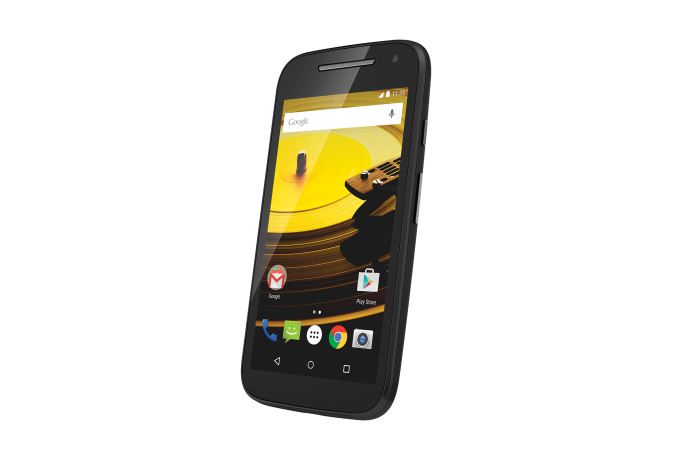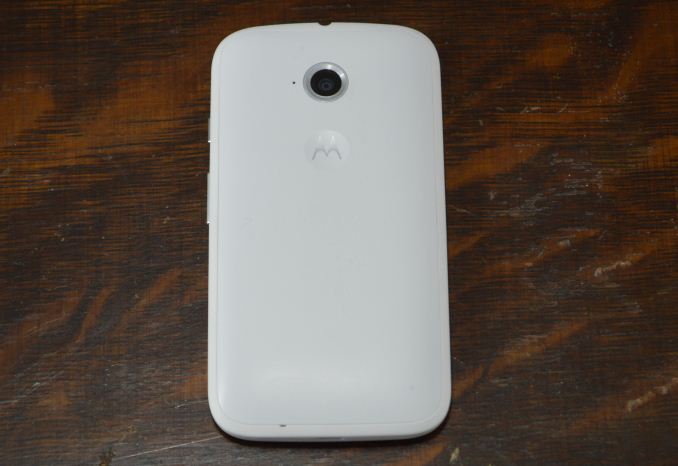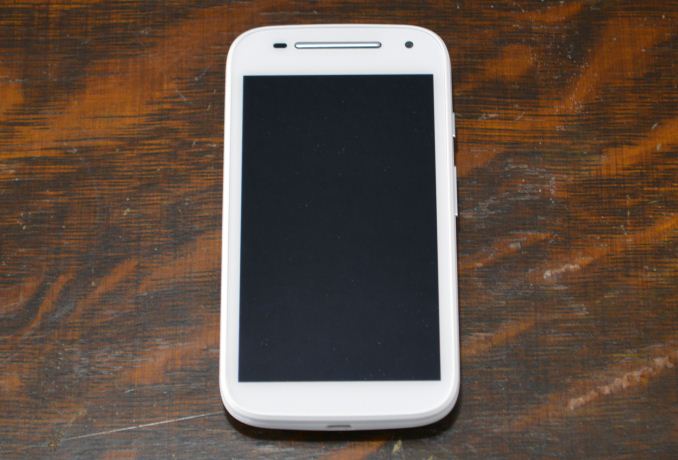Motorola Announces Moto E (2015): Cortex-A53 + LTE For $149
by Andrei Frumusanu on February 25, 2015 3:00 PM EST- Posted in
- Smartphones
- Motorola
- Mobile
- Moto E
- Moto E (2015)

Today Motorola has announced the launch and immediate availability of the 2015 version of the Moto E, the latest member of the company’s line of low-end smartphones.
The 2015 edition of the Moto E is a pretty hefty upgrade of a phone launched just 9 months ago. In terms of design the new Moto E is generally a bigger, more powerful version of its predecessor, retaining the same rounded plastic design while enlarging the overall body slightly to house the larger 4.5" screen. Meanwhile Motorola has iterated on the 2014’s swappable back covers, with the 2015 featuring the ability to swap in one of the company’s newer grip shells, or the phone’s colored bands can be swapped out separately.
| Motorola's 2015 Low-End Smartphone Lineup | ||||||
| Motorola Moto E (2015) | Motorola Moto E (2014) | Motorola Moto G (2014) | ||||
| SoC | Qualcomm Snapdragon 410 (MSM8916) 4x Cortex A53 @ 1.2GHz Adreno 306 at 400MHz (LTE model XT1527) or Qualcomm Snapdragon 200 (MSM8x10) 4x Cortex A7 @ 1.2GHz Adreno 302 at 400MHz (3G models) |
Qualcomm Snapdragon 200 (MSM8x10) 2x Cortex A7 @ 1.2GHz Adreno 302 at 400MHz |
Qualcomm Snapdragon 400 (MSM8x26) 4x Cortex A7 @ 1.2 GHz Adreno 305 at 450MHz |
|||
| RAM/NAND | 1GB LPDDR3 8GB NAND & MicroSD |
1GB LPDDR2 4GB NAND & MicroSD |
1GB LPDDR3 8/16GB NAND & MicroSD |
|||
| Display | 4.5" 960x540 LCD | 4.3" 960x540 LCD | 5" 1280x720 IPS LCD | |||
| Dimensions | 129.9 x 66.8 x 12.3mm 145g |
124.38 x 64.8 x 12.3mm 142g |
141.5 x 70.7 x 11.0 mm 149g | |||
| Camera | 5MP (2592 х 1944) Rear Facing w/Auto Focus, F/2.2 aperture VGA (640x480) Front Facing |
5MP (2592 х 1944) Rear Facing w/Fixed Focus | 8MP (2592 х 1944) Rear Facing 2MP (1280x720) Front Facing |
|||
| Battery | 2390 mAh (9.08 Whr) | 1980 mAh (7.52 Whr) | 2070 mAh (7.87 Whr) | |||
| OS | Android 5.0 | Android 4.4.2 | Android 4.4.4 | |||
| Connectivity | 802.11 b/g/n + BT 4.0, USB2.0, GPS/GNSS | 802.11 b/g/n + BT 4.0, USB2.0, GPS/GNSS | 802.11 b/g/n + BT 4.0, USB2.0, GPS/GNSS | |||
| SIM Size | Micro-SIM | Micro-SIM (Dual SIM SKU) |
Micro-SIM | |||
The phone is being released in two versions. The first being the LTE model which primarily targets the US market in its LTE frequency bands. There are also a pair of 3G versions, with one again targeted at the US and the other more globally, with the big difference being the US 3G version's support of the 1700MHz AWS frequency bands for HSPA+.
| Motorolla E (2015) Model Breakdown | ||||||
| Region | GSM | UMTS/HSPA+ | LTE | |||
| 4G LTE - US GSM (XT1527) |
850, 900, 1800, 1900 | 850, 1700, 1900 | 2, 4, 5, 7, 12, 17 | |||
| US GSM (XT1511) | 850, 900, 1800, 1900 | 850, 1700, 1900 | - | |||
| Global GSM (XT1505) | 850, 900, 1800, 1900 | 850, 900, 1900, 2100 | - |
|||
Priced at $149, the LTE version features a Qualcomm Snapdragon 410 processor, which supplies both the quad-core Cortex-A53 CPU and the Category 4 LTE modem. The 3G versions will be launching later at $119 – the biggest difference here is the use of a Snapdragon 200 series SoC with a quad-core Cortex-A7 CPU instead of the newer A53 Snapdragon 410. Having received the LTE version from Motorola, for our purposes we’ll be focusing on the LTE version.
Likely the single biggest draw for the 2015 Moto E over the 2014 is the inclusion of LTE support, which is a first for a low-end Motorola phone, and in fact is something even the higher-tier 2014 Moto G did not include. Driven by the 9x25 modem integrated into the Snapdragon 410, this gives the Moto E Cat 4 LTE capabilities along the most common North American bands.
Meanwhile users of either version will also quickly notice the larger screen, which sees a slight bump to 4.5”, up from 4.3” in the 2014 version. Though larger, the resolution though remains entry-level at qHD (960x540) pixels, so pixel density has decreased some compared to the 2014 version. Helping to drive this larger display and to take advantage of the larger phone body is a 2390mAh battery, 410mAh more than in last year's model. Even accounting for the larger screen battery life should be improved over the 2014 version – particularly stand-by time – however we’ll have to give the phone a complete rundown to see what the real-world gains are.
Next to the screen and new to this year’s version is a front-facing VGA (640x480, 0.3MP) camera. The 2014 model skipped out on a camera entirely for cost reasons, and while this camera is of limited use, it should be reasonable enough for selfies and video chat on an entry level phone. Meanwhile the rear facing camera is still 5MP, however it’s now capable of auto focus versus last year’s fixed focus camera. As for video recording, this camera is used to record at 720p30, a significant step up from the 2014’s FWVGA (854x480) recording capabilities.
Storage has also seen a bump up, going from 4GB on-board to 8GB on-board, and users still looking for more can add more storage via microSD. The accompanying RAM on the other hand remains at 1GB, though it’s now LPDDR3 as opposed to LPDDR2.
Finally, the phone is shipping with Android 5.0 Lollipop, making it the first Motorola-branded phone to ship with Android 5.0 out of the factory and joining Motorola’s other phones which recently received the OS as an update. Motorola doesn’t specify whether they’re using a 32-bit or 64-bit version of the OS, however a quick check of the phone finds that it's running the 32-bit version of Android. Which given the fact that the 2015 Moto E is available with both Cortex-A53 and Cortex-A7 based SoCs, it makes sense that the company is sticking to 32-bit throughout.
We will be putting the new Moto E through its paces in the coming weeks, but so far it looks like a solid update to the Moto E lineup. At $149 for the LTE it does end up debuting at $20 more expensive than the previous version in what’s a very price sensitive market, so it will be interesting to see how consumers respond to the higher price. But LTE tends to be a big draw.
Shipping today, US customers can order the LTE version of the phone from Motorola’s website. Meanwhile international customers can look forward to Motorola rolling out the phone to more than 50 countries in the Americas, Europe, and Asia.
Source: Motorola





 Side - White_thumb.jpg)
 Back - Black_thumb.jpg)
 Back - White_thumb.jpg)
 Back Dynamic - Black_thumb.jpg)
 Front - White_thumb.jpg)
 Front Dynamic - Black_thumb.jpg)








29 Comments
View All Comments
dullard - Wednesday, February 25, 2015 - link
I'm impressed that they could get a 4.5 foot screen into such a small body."enlarging the overall body slightly to house the larger 4.5’ screen"
Maxpower2727 - Thursday, February 26, 2015 - link
Imagine how small it would be if the bezels weren't so gigantic.aggiechase37 - Wednesday, February 25, 2015 - link
So since Lenovo owns Moto now, can we expect that the phone is chock full of spyware?WorldWithoutMadness - Wednesday, February 25, 2015 - link
This phone is pointless.1. It is ugly
2. For that price, you can get something better like moto g 1st gen (of course non LTE) but you can even get redmi 2 which support LTE for around that price
3. For developing countries such as India, Indonesia, etc, they have Android One which basically the same spec for 100$ or less and not to forget motorola update is undeniably rubbish after the acquisition compared to google era.
d4Njv - Wednesday, February 25, 2015 - link
"Finally, the phone is shipping with Android 5.0 Lollipop, making it the first Motorola-branded phone to ship with Android 5.0 out of the factory and joining Motorola’s other phones which recently received the OS as an update. "So how is the Snapdragon 200 version going to cope with Lollipop's full device encryption, which is always enabled on all new installs? As Anandtech documented with the Nexus 6 (http://www.anandtech.com/show/8725/encryption-and-... the FDE will cripple storage performance unless the device has hardware crypto acceleration like what comes with all 64-bit ARMs.
blzd - Friday, February 27, 2015 - link
Not ever device that ships with L is forced to use full device encryption. That was Google's decision with the N6 and N9 and manufacturers can decide for their own devices.NAK - Thursday, February 26, 2015 - link
It seems to me its just a new version of Moto G with only an extra option of external memory.blzd - Friday, February 27, 2015 - link
Some sites are reporting that this is using an OLED display. I find it hard to believe but would be nice to see a confirmation.rknize - Wednesday, March 4, 2015 - link
It was the factory data reset that facilitated the switch from EXT4 to F2FS on the 2014 X.